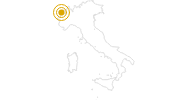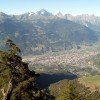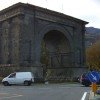Contents
Route description
Start the tour at the chapel San Rocco at Corso Ivrea. During the Roman Age the biggest necropolis was based there. Afterwards pass the square with the so called Augustenbogen, which was built to demonstrate the victory over the Salassi and celebrate the new annexed colony. Then cross the bridge called „Römerbrücke“.
You will pass Via Sant'anselmo. That district was only evolved in the Middle Ages, especially with the construction of the church of Sant'Orso, which you should definitely visit. Before that the area was used as a cemetery for local martyrs and first bishops thus it quickly became a pilgrimage site. The church was built close to the former basilica, which was built in the 5th century and shows an archaeological site with remains of the first burial church.
Very impressive is the bell tower, which was originally built as a defence tower. Inside the church you can see a remarkable romanesque crypt from the 11th century in which apparently the holy Sant'Orso was buried. In addition you can take an accompanied visit to the attic to see the renowned Ottonian fresco cycle.
Now go back to Via Sant'Anselmo and continue to the city gate Porta Praetoria. Porta Praetoria symbolises the entry of the colony Augusta Praetoria Salassorum. The former aristocratic family resided in the north tower during the Middle Ages.
Afterwards turn right to the Roman theatre, which is within the so called entertainment district.
Leave the theater towards west and walk to Piazza Giovanni CCIII, „the cathedral's square“. During Roman times two twin temples where placed on that square. Nowadays you can see some remains of the tower.
Next stop is the cryptoporticus, which in Ancient Roman architecture is a covered corridor or passageway.
Above the cryptoporticus stands the cathedral Mariä-Himmelfahrt from the 4th century. This church was remodeled in the 11th century by bishop Anselmo which explains the Ottonian influence in today's architectual style of the church.
Now take Via Forum and walk to Piazza Roncas, where the archaeology museum MAR (Museo Archeologico Regionale) is located. Opposite to the museum stands Palais Roncas the baroque noble residence of baron Pierre-Leonard Roncas.
Continue further on Via Croix de Ville until you reach a junction, where the two main streets of the city center cross each other. Take Via E. Aubert and walk towards the library.
Now cross Piazza della Repubblicca and you will get to Corso Battaglione. Underneath some pergolas you will find an iron grille, which leads to the archaeological site „Porta Decumana“. The site shows various Ancient Roman tombs and an Early Christian remnant of a small burial church.
You can visit the site every first monday of a month between 2 pm and 6 pm.
Now go back to the church and down to the leper's tower, from where you continue on Via Festaz until you reach the movie theater Splendor. From there continue further on Via Trottechien to the passage du Verger, which merges into Via Challant and into Via De Tillier.
The tour ends at Piazza E. Chanoux, where the hotel de Ville is located nowadays. In earlier times that space was occupied by a church named San Francesco.
Where to eat
The city Aosta offers many restaurants to dine in.
Interesting facts
- You're traveling a distance of 4 km on this easy trail. The hike is therefore not too long. Average length of all hikes in the Aosta Valley is 12 km.
- This easy hike is perfect for the whole family.
- Hiking boots are not required, but the hike might be more enjoyable with sturdy footwear (especially in wet conditions). If you get hungry along the way, there are places to rest and get food. Nevertheless it’s recommended to also have enough water and food in your backpack when hiking or biking.
Highlights of the tour
The tour guides you along all highlights from ancient and medieval times within the city Aosta, namely the chapel San Rocco, the arch Augustbogen, the church Sant'Orso and the city gate Porta Praetoria.
Getting here
By car:
Corso Ivrea is located directly on SS26 and is therefore easy to reach by car.




